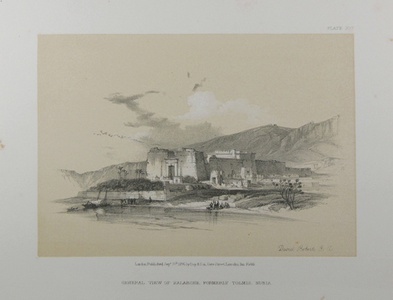| Method | Lithograph with tint stone |
| Artist | after David Roberts |
| Published | London, Published Sepr. 15th. 1856, by Day & Son, Gate Street, Lincoln's Inn Fields |
| Dimensions | Image 125 x 178 mm, Sheet 202 x 285 mm |
| Notes |
Plate 207 from Volume 5 of the small format reprint of Roberts' The Holy Land, Syria, Idumea, Arabia, Egypt & Nubia. A general view from the Nile of the temple of Kalabsha, in the ancient Egyptian region of Nubia. The temple was built during the late 1st century BC on the orders of the Roman emperor Augustus, and was dedicated to Mandulis, a local Nubian aspect of the Egyptian falcon-god, Horus. The temple, built over an existing sanctuary of Amenhotep II, was never finished, but remains one of the finest examples of Nubian-Egyptian architecture. The temple was moved in the 1960s to the site of New Kalabsha to preserve it from the rising waters of Lake Nasser following the extention of the Aswan Dam. Robert's view shows the extent of the temple and its impressive enclosure walls. The decorative gateway lintel and monumental pylon is shown at centre, with numerous small shrines dispersed between the rooftops of the Nubian mud-brick houses that have grown up around the Temple site. Two small domes in the courtyard before the temple indicate a mosque, or perhaps an Islamic bathhouse. On the banks of the Nile, a group of women collect water in large urns while a group of men unload a felucca moored further up the bank. David Roberts RA (24th October 1796 – 25th November 1864) was a Scottish painter. He is especially known for a prolific series of detailed prints of Egypt and the Near East produced during the 1840s from sketches made during long tours of the region (1838-1840). This work, and his large oil paintings of similar subjects, made him a prominent Orientalist painter. He was elected as a Royal Academician in 1841. The firm of Day & Haghe was one of the most prominent lithographic companies of the nineteenth-century. They were also amongst the foremost pioneers in the evolution of chromolithography. The firm was established in 1823 by William Day, but did not trade under the moniker of Day & Haghe until the arrival of Louis Haghe in 1831. In 1838, Day & Haghe were appointed as Lithographers to the Queen. However, and perhaps owing to the fact that there was never a formal partnership between the two, Haghe left the firm in the 1850's to devote himself to watercolour painting. The firm continued as Day & Son under the guidance of William Day the younger (1823 - 1906) but, as a result of a scandal involving Lajos Kossuth, was forced into liquidation in 1867. Vincent Brookes bought the company in the same year, and would produce the caricatures for Gibson Bowles' Vanity Fair magazine, as well as the illustrations for Cassells's Poultry Book, amongst other commissions. Condition: Light foxing to margins, not affecting image. |
| Framing | unmounted |
| Price | £30.00 |
| Stock ID | 39201 |

